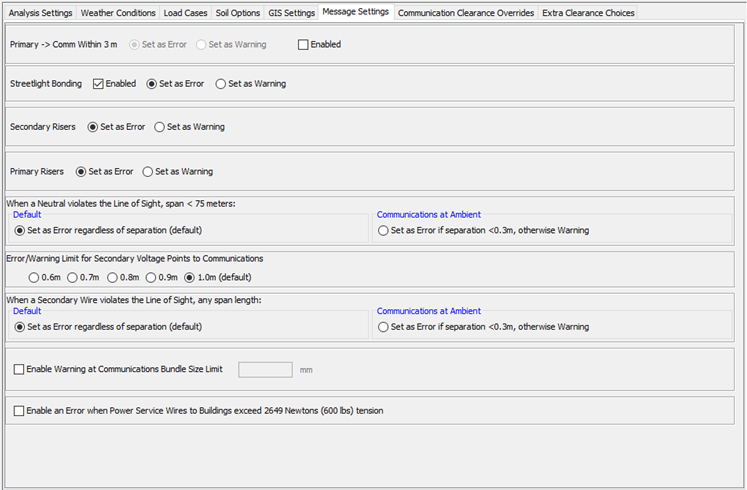Message Settings
In this tab you can customize "how" and in some cases "if" Quick Pole will generate a message for certain conditions. This list of message options may grow in the future as it is driven by customer requirements. Some items cannot be ignored since they involve CSA/NESC code requirements. In that case they can only be adjusted to be interpreted as either an Error or just a Warning, but will always generate a message/indicators if violated.
In some cases, deviations from national codes are permitted if a professional engineer or other competent person accepts responsibility for the safety of workers and the public. They may do this for construction on older plant if they understand the safety risks involved. In these cases the below options can sometimes change a RED error message to an ORANGE warning, which often get copied to the associated work orders.

- Primary->Comm Within 3m. A message can be generated if the top communications strand is within 3.0 meters (10 feet) of any identified primary voltage. For this feature to work, the lowest primary wires on the pole must have their voltage set to 750-22000 volts or greater. Primary Voltage Points can be added as an equipment item to facilitate detection of the lowest connection/device wire on the pole that is energized to primary voltages.
- Streetlight Bonding. If a Street Light is within 1.0 meters (40 inches) or below a Communications Messenger, it may not be properly grounded. There is a field to capture if a specific streetlight is bonded/grounded in the Structure Window, and if set, there would be no message generated in any event. Otherwise Quick Pole will generate a message if the streetlight falls within the separation criteria. In this case the generated message can be either an Error or a Warning.
- Secondary Risers. This item if for cases where Secondary Power Riser Cables/Conduit are not fully mechanically protected 1.0 meters (40 inches) or higher above the top communications strand.
- Primary Risers. This item if for cases where Primary Power Riser Cables are not fully mechanically protected 1.0 meters (40 inches) or higher above the top communications strand.
- When a Neutral violates the Line of Sight.... This option will adjust Line of Sight violations for neutral wires on spans less than 75 meters that have at least 0.3m of in-span vertical separation, to be Warnings as opposed to Error messages. Power Conductors that are Neutral Wires need to be identified properly for this to function properly.
- Error/Warning Limit for Secondary Voltage Points... For items like triplex drip loops at the pole, many Designers allow closer separation requirements for items that come closer to the communication space at a certain location. Secondary Voltage Points can be located on the pole as a special equipment item at the lowest height measured in the field. This option will enable closeness of less than 1.0 meter (40 inches) to be flagged as a Warning as opposed to an Error.
- When a Secondary Wire violates the Line of Sight.... This option will adjust Line of Sight violations for secondary wires on spans of any length that have at least 0.3m (12 inches) of in-span vertical separation, to be Warnings as opposed to Error messages. Power Conductors that are Secondary Wires need to be identified as having voltage <=750 volts for this to function properly.
- Enable Warning at Communications Bundle Size Limit. Enable this option and set a value that you wish to be notified when a Communications Bundle Diameter exceeds this threshold.
- Detect Attachment loads for Buildings > Service Mast Limits (2649N). This item will evaluate the maximum tension of Power Service wires at building locations and detect any situation where it is greater than the amount permitted for Building Service Masts (600 lbs, 2649 Newtons); typical values for residential power service masts. Some caution should be used if Attachment Nonlinearity is enabled for poles with Power Services as they could be calculated to higher tension loads than the service wires may actually experience.